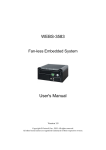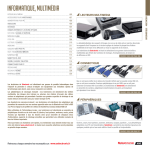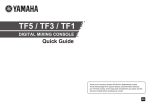Download WADE-8015 User's Manual
Transcript
WADE-8015
Mini-ITX Board
User's Manual
Version 1.0
Copyright © Portwell, Inc., 2013. All rights reserved.
All other brand names are registered trademarks of their respective owners.
Preface
Table of Contents
How to Use This Manual
Chapter 1 System Overview.......................................................................................................1-1
1.1 Introduction ....................................................................................................... 1-1
1.2 Check List........................................................................................................... 1-2
1.3 Product Specification........................................................................................ 1-2
1.3.1 Mechanical Drawing................................................................................ 1-5
1.4 System Architecture.......................................................................................... 1-6
Chapter 2 Hardware Configuration ...........................................................................................2-1
2.1 Jumper Setting ................................................................................................... 2-1
2.2 Connector Allocation........................................................................................ 2-3
Chapter 3 System Installation....................................................................................................3-1
3.1 Intel Haswell Processor.................................................................................... 3-1
3.2 Main Memory .................................................................................................... 3-4
3.3 Installing the Mini-ITX Board Computer ...................................................... 3-5
3.3.1 Chipset Component Driver .................................................................... 3-5
3.3.2 Intel® Integrated Graphics Controller.................................................. 3-5
3.3.3 On-board Gigabit Ethernet Controller.................................................. 3-5
3.3.4 Audio Controller ...................................................................................... 3-5
3.4 Clear CMOS Operation .................................................................................... 3-6
3.5 WDT Function ................................................................................................... 3-6
3.6 GPIO.................................................................................................................... 3-7
Chapter 4 BIOS Setup Information............................................................................................4-1
4.1 Entering Setup ................................................................................................... 4-1
4.2 Main .................................................................................................................... 4-3
4.3 Advanced ........................................................................................................... 4-4
4.4 Security ............................................................................................................. 4-32
4.5 Boot ................................................................................................................... 4-33
4.6 Exit..................................................................................................................... 4-34
Chapter 5 Troubleshooting ........................................................................................................5-1
5.1 Hardware Quick Installation........................................................................... 5-1
5.2 FAQ ..................................................................................................................... 5-2
Preface
How to Use This Manual
The manual describes how to configure your WADE-8015 system board to meet
various operating requirements. It is divided into five chapters, with each chapter
addressing a basic concept and operation of Single Host Board.
Chapter 1: System Overview. Presents what you have in the box and give you an
overview of the product specifications and basic system architecture for this series
model of single host board.
Chapter 2: Hardware Configuration. Show the definitions and locations of Jumpers
and Connectors that you can easily configure your system.
Chapter 3: System Installation. Describes how to properly mount the CPU, main
memory and Compact Flash to get a safe installation and provides a programming
guide of Watch Dog Timer function.
Chapter 4: BIOS Setup Information. Specifies the meaning of each setup
parameters, how to get advanced BIOS performance and update new BIOS. In
addition, POST checkpoint list will give users some guidelines of trouble-shooting.
Chapter 5: Troubleshooting. Provide various of useful tips to quickly get
WADE-8015 running with success. As basic hardware installation has been
addressed in Chapter 3, this chapter will basically focus on system integration issues,
in terms of backplane setup, BIOS setting, and OS diagnostics.
The content of this manual is subject to change without prior notice. These changes
will be incorporated in new editions of the document. The vendor may make
supplement or change in the products described in this document at any time.
System Overview
Chapter 1
System Overview
1.1 Introduction
Portwell Inc., a world-leading innovator in the Industrial PC (IPC) market and a
member of the Intel® Embedded and Communications Alliance (Intel ECA),
announced today the Portwell WADE-8015 adopting the Mini-ITX form factor. The
WADE-8015 of the Intel platform will provide high performance and flexibility for
functional expansion, such as Gaming, Kiosk, DS, Medical, Defense, Industrial
automation and control applications.
Haswell is the next major architecture from Intel. The WADE-8015 supports the
latest Intel® Haswell processors in LGA1150 package which has memory and PCI
Express controller integrated to support 2-channel DDR3 memory and PCI Express
3.0 lanes providing great graphics performance. Intel® Haswell processor is one of
the most powerful and energy efficient CPU in the world. Portwell have taken
advantage of such technology to furnish a series of products that can meet multiple
industrial requirements such as cost-effective of CPU performance or industrial
systems.
WADE-8015 is based on the Intel® Haswell processor and Intel® Q87 chipset. The
Intel Q87 Express Chipset, when combined with a processor from the Intel® Dual
Core/Quad Core processor family, delivers smart security, cost saving
manageability, and intelligent performance for business platforms. WADE-8015 is the
first Portwell off-the-shelf product for by Intel® Q87 Express Chipset, it can be an
embedded solution and a good platform for customer to integrate it to the embedded
system.
WADE-8015 showcased one of Portwell upcoming motherboard for the Intel®
Haswell processors . The WADE-8015 is based on the forthcoming Intel Q87 chipset
and supports the new LGA 1150 socket (socket that will be used by Haswell
processors). This board has lots of features, including supports total 4x SATA 3 (SAT
6.0 Gbps) storage specification , allows RAID 0/1/5 and 10. supports the latest PCIe
3.0 (one PCI-Express x16 slot) devices for double speed and bandwidth which
enhances system performance, two long-DIMM memory slot for DDR3 SDRAM up to
16GB, support total 8 USB2.0 ports (4x rear IO by USB3.0 / 4x on board by USB2.0),
VGA / HDMI / DP , two Gigabit Ethernet and one mini-PCIe slot support mSATA.
WADE-8015 User’s Manual
1-1
System Overview
1.2
Check List
The WADE-8015 package should cover the following basic items
9
9
9
9
One WADE-8015 Mini-ITX Main Board
One SATA Cable
One I/O Shield bracket
One Installation Resources CD-Title
If any of these items is damaged or missing, please contact your vendor and keep all
packing materials for future replacement and maintenance.
1.3 Product Specification
z Main Processor
-Intel® Dual Core/Quad Core LGA1150 processor
-CPU clock bus: 1333/1600 MHz
z Chipset
-Intel® Q87 chipset
z System BIOS
-Phoenix BIOS
z Main Memory
-Two 240 -pin DDR3 Long-DIMM socket support up to 16GB dual channel
1333/1600 MHz memory
z Expansion Interface
-One PCIex16
-One Mini-PCIe slot(support mSATA)
-One PCIe x1 gold finger(include 2x PCIex1 signal)
z SATA Interface
-Four SATA 6Gb ports
z Serial Port
-Support total six com ports(one RS232 and one RS232/422/485 on rear
S/O, three RS232 and one RS232/422/485 on board header)
z USB Interface
-Support Eight USB (Universal Serial Bus) ports, four on rear I/O(USB3.0) and Six
on board header(USB2.0) for internal devices
z Audio Interface
-Connector for Mic-In, Line-In and Line-Out
z Real Time Clock/Calendar (RTC)
-Support Y2K Real Time Clock/Calendar
WADE-8015 User’s Manual
1-2
System Overview
z Watch Dog Timer
-Support WDT function through software programming for enable/disable
and interval setting
-General system reset
z On-board Ethernet LAN
-Two Gigabit Ethernet (10/100/1000 Mbits/sec) LAN ports using Intel
WGI217LM & WGI210AT GbE Ethernet Controller
z High Drive GPIO
-One pin-header for 16 bit GPIO (8bit in & 8bit out)
z System Monitoring Feature
-Monitor system temperature and major power sources.
z Outline Dimension (L x W)
-170mm(6.69’’) x 170mm(6.69’’)
z Power Requirements
Item
Power ON
CPU +12V
System +12V
System +3.3V
System +5V
System+ Device +12V
System+ Device +5V
USB Loading Test
z Configurations
CPU Type
SBC BIOS
Memory
VGA Card
VGA Driver
LAN Card
LAN Driver
LAN Card
LAN Driver
Audio Card
Audio Driver
Chip Driver
USB3.0 Driver
SATA HDD
WADE-8015 User’s Manual
Full Loading
10Min
1.14
1.18
0.77
1.37
0.45
0.62
0.84
1.35
1.16
1.70
1.98
1.73
4.89~4.96 V/ 510 mA
Full Loading
30Min
1.07
1.34
0.60
1.27
1.72
1.72
Intel(R) Core(TM) i7-4770S CPU @ 3.10GHz L3: 8 MByte
Portwell,Inc. WADE-8015 TEST BIOS(30312T00)
Transcend DDR3 1333 UB-DIMM 1GB*1(K4B1G0846F)
Onboard Intel Haswell HD Graphics-GT2
Intel Haswell HD Graphics-GT2 Version:9.17.10.2895
Onboard Intel® Ethernet Connection I217-LM
Intel® Ethernet Connection I217-LM Version:12.3.30.0
Onboard Intel® I210 Gigabit Network Connection
Intel® I210 Gigabit Network Connection Version:12.3.35.0
Onboard Realtek ALC886 High Definition Audio
Realtek ALC886 High Definition Audio Version:6.0.1.6662
Intel(R) Q87 LPC Controller - 8C4E Version 9.4.0.1011
Intel® USB 3.0 extensible Host Controller Version:2.0.0.100
Seagate ST3160316AS 160GB
1-3
System Overview
z Operting Temperature
0 °C ~ 60 °C
z Storage Temperature
-20 ~ 80 °C
z Relative Humidity
0% ~ 90%, non-condensing
WADE-8015 User’s Manual
1-4
System Overview
1.3.1 Mechanical Drawing
WADE-8015 User’s Manual
1-5
System Overview
1.4 System Architecture
All of details operating relations are shown in WADE-8015 System Block Diagram.
WADE-8015System Block Diagram
WADE-8015 User’s Manual
1-6
Hardware Configuration
Chapter 2
Hardware Configuration
This chapter indicates jumpers’, headers’ and CONNECTORs’ locations. Users may
find useful information related to hardware settings in this chapter.
2.1 Jumper Setting
WADE-8015 User’s Manual
2-1
Hardware Configuration
The jumper settings are schematically depicted in this manual as follows:
“Ì“ mean default
JP1 : Mni PCIE & mSATA
JP1
Short
Open
Function
Mini PCIE Ì
mSATA
JP3: AUTO POWER BUTTON Select
JP3
short
open
Function
Auto power button enable
Auto power button disable Ì
JP4: Clear CMOS Header
JP4
1-2 Short
2-3 Short
Function
No function Ì
Clear CMOS
JP5: Case Open detection
JP5
short
open
Function
Case open enable
No function Ì
J8 COM1 RIfunction Selection
J8
3-4 short
3-1 short
3-5 short
Function
RI# Ì
5V
12V
J9 COM2 RI#function Selection
J9
3-4 short
3-1 short
3-5 short
Function
RI# Ì
5V
12V
WADE-8015 User’s Manual
2-2
Hardware Configuration
2.2 Connector Allocation
I/O peripheral devices are connected to the interface connectors.
Connector Function List
Connector
J1A
J1B
COM2
J2
Display port
J3
VGA
J4
Audio jack
J5
HDMI connector
J6
USB 3.0 X2 + RJ-45(I217)
J7
USB 3.0 X2 + RJ-45(I210)
J10
KB/MS
J11
PCIE 2X1 gold finger
J12
JP2
J13
COM6
COM4
Mini PCIE
COM3
COM5
GPIO
ATX 2X2 power connector
ATX 24 pin power connector
battery connector
PCIE X16 slot
front panel control header
USB header
SATA3 connector
TPM
CPU fan
System fan
DDR3 slot
J14
J15
J16
J17
J18
J19
J20
J21
J22/J23/J24
J25/J26/J28/J29
J27
J31
J32
J33/J34
WADE-8015 User’s Manual
Function
COM1
Remark
2-3
Hardware Configuration
Pin Assignments of Connectors
J1: COM1&COM2
J1A:COM1 Serial Port
PIN No.
Signal Description
1
DCD#1
2
RXD#1
3
TXD#1
4
DTR#1
5
GND
6
DSR#1
7
RTS#1
8
CTS#1
9
RI#1
J1B:COM2 Serial Port
PIN No.
Signal Description
1
DCD#2/DT2
RXD#2/DT+
3
TXD#2/422R+
4
DTR#2/422R5
GND
6
DSR#2
7
RTS#2
8
CTS#2
9
RI#2
J2:Display port Connector
PIN No. Signal Description
1
D0+
3
D05
GND
7
D2+
9
D211
GND
13
AUX_EN#
15
AUX+
17
AUX19
GND
WADE-8015 User’s Manual
PIN No. Signal Description
2
GND
4
D1+
6
D18
GND
10
D3+
12
D314
GND
16
GND
18
Hot plug
20
VCC3
2-4
Hardware Configuration
J3:VGA Connector
PIN No. Signal Description
1
Red
3
Blue
5
GND
7
GGND
9
KEY(+5V)
11
NC
13
H Sync
15
SCL
PIN No.
2
4
6
8
10
12
14
16
Signal Description
Green
NC
RGND
BGND
SGND
SDA
V Sync
PIN No.
2
4
6
8
10
12
14
16
18
Signal Description
GND
D1+
D1GND
D3+
D3NC
DDCDATA
VCC5
J10:PS/2 Keyboard/Mouse Pin Header
PIN No. Signal Description
1
Mouse Data
3
N/C
5
Ground
7
PS2 Power
9
Mouse Clock
PIN No.
2
4
6
8
10
Signal Description
Keyboard Data
N/C
Ground
PS2 Power
Keyboard Clock
J11:PCIE GOLD FINGER
PIN No. Signal Description
B1
12V
B2
12V
B3
VCC3
B4
GND
B5
CLK_CF2_PCIE_DP
B6
CLK_CF2_PCIE_DN
B7
GND
B8
VCC3
B9
VCC3
PIN No.
A1
A2
A3
A4
A5
A6
A7
A8
A9
Signal Description
SMBCLK
12V
12V
GND
PCIE_TX6_DP
PCIE_TX6_DN
PCIE_RX6_DP
PCIE_RX6_DN
VCC3
J5:HDMI Connector
PIN No. Signal Description
1
D0+
3
D05
GND
7
D2+
9
D211
GND
13
NC
15
DDCCLK
17
GND
19
HPD
WADE-8015 User’s Manual
2-5
Hardware Configuration
PIN No.
B10
B11
B12
B13
B14
B15
B16
B17
B18
Signal Description
3VSB
PCIE_WAKE#
SMBDAT
GND
PCIE_TX7_DP
PCIE_TX7_DN
GND
VCC3
GND
PIN No.
A10
A11
A12
A13
A14
A15
A16
A17
A18
Signal Description
VCC3
PCIRST
GND
CLK_CF2_PCIE_DP
CLK_CF2_PCIE_DN
GND
PCIE_RX7_DP
PCIE_RX7_DN
GND
J12:COM6 Serial Port Pin Header
PIN No.
Signal Description
1
DCD#6
2
RXD#6/DT+
3
TXD#6/422R+
4
DTR#6
5
GND
6
DSR#6
7
RTS#6
8
CTS#6
9
RI#6
10
N/C
J14:COM3 Serial Port Pin Header
PIN No.
Signal Description
1
DCD#3
2
RXD#3
3
TXD#3
4
DTR#3
5
GND
6
DSR#3
7
RTS#3
8
CTS#3
9
RI#3
10
N/C
WADE-8015 User’s Manual
2-6
Hardware Configuration
JP2:COM4 Serial Port Pin Header
PIN No.
Signal Description
1
DCD#4
2
RXD#4
3
TXD#4
4
DTR#4
5
GND
6
DSR#4
7
RTS#4
8
CTS#4
9
RI#4
10
N/C
J15:COM5 Serial Port Pin Header
PIN No.
Signal Description
1
DCD#5
2
RXD#5
3
TXD#5
4
DTR#5
5
GND
6
DSR#5
7
RTS#5
8
CTS#5
9
RI#5
10
N/C
J16:GPIO Pin Header
PIN No. Signal Description
1
GPIO0
3
GPIO1
5
GPIO2
7
GPIO3
9
Ground
PIN No.
2
4
6
8
10
Signal Description
GPIO4
GPIO5
GPIO6
GPIO7
+5V
J17:ATX 2X2 power connector
Pin No.
Signal Description
1
GND
2
GND
3
+12V
4
+12V
WADE-8015 User’s Manual
2-7
Hardware Configuration
J21:Front Panel Pin Header
PIN No. Signal Description
1
VCC
3
SATA_LED#
5
GND
7
RSTBTN#
9
VCC
11
GND
13
VCC
PIN No.
2
4
6
8
10
12
14
Signal Description
5VSB
POWER_LED
Power Button
GND
BUZZER
GND
NC
1-3 SATA LED、2-4 Power LED
5-7 Reset Button、6-8 Power Button、9-10 Buzzer
J22/J23/J24/:USB2.0 Pin Header
PIN No. Signal Description
1
5V Dual
3
USB5
USB+
7
Ground
9
Key
PIN No.
2
4
6
8
10
Signal Description
5V Dual
USBUSB+
Ground
N/C
PIN No.
2
4
6
8
10
12
14
16
18
20
Signal Description
GND
X
VCC
LAD2
LAD1
GND
SMB_DATA_MAIN
SERIRQ
X
X
J26:SMBUS Pin Header
PIN No. Signal Description
1
SMBus_CLK
2
N/C
3
Ground
4
SMBus_DAT
5
+5V
J27:TPM Pin Header
PIN No. Signal Description
1
PCLK_TPM
3
LFRAME#
5
SIO2_PLTRST#
7
LAD3
9
VCC3
11
LAD0
13
SMB_CLK_MAIN
15
3VSB
17
GND
19
LPCPD#
WADE-8015 User’s Manual
2-8
Hardware Configuration
J31:CPU Fan Connector
PIN No. Signal Description
1
Ground
2
+12V
3
Sense output
4
FAN PWM_CONTROL
J32:System Fan Connector
PIN No. Signal Description
1
Ground
2
FAN PWM_CONTROL
3
Sense output
WADE-8015 User’s Manual
2-9
BIOS Setup Information
Chapter 3
System Installation
This chapter provides you with instructions to set up your system. The additional
information is enclosed to help you set up onboard PCI device and handle Watch
Dog Timer (WDT) and operation of GPIO in software programming.
3.1 Intel Haswell Processor
LGA-1150 CPU Socket
LGA-1150 CPU
Please remember to locate the alignment keys on the CPU socket of the
motherboard and the notches on the CPU.
WADE-8015 User’s Manual
3-1
BIOS Setup Information
LGA-1150 CPU Installation Steps
Before install the CPU, please make sure to turn off the power first!!
1. Open the load lever.
2. Lift the load lever up to fully open.
3. Remove the plastic cap on the CPU socket. Before you install the CPU, always
cover it to protect the socket pin.
WADE-8015 User’s Manual
3-2
BIOS Setup Information
4. After confirming the CPU direction for correct mating, put down the CPU in
the
socket housing frame. Note that alignment keys are matched.
5. Make sure the CPU has been seated well into the socket. If not, take out the
CPU
and reinstall.
6. Engage the load lever while pressing down lightly onto the load plate.
WADE-8015 User’s Manual
3-3
BIOS Setup Information
7. Push the CPU socket lever back into its locked position.
8. Please make sure four hooks are in proper position before you install the cooler.
3.2 Main Memory
WADE-8015 has two 240 pin DIMM sockets which supports Dual channel
1333/1600 DDR3-SDRAM as main memory, Non-ECC (Error Checking and
Correcting), non-register functions. The maximum memory can be up to 16GB.
Memory clock and related settings can be detected by BIOS via SPD interface.
For system compatibility and stability, do not use memory module without
brand. Memory configuration can be set to either one double-sided DIMM in one
DIMM socket or two single-sided DIMM in both sockets.
Beware of the connection and lock integrity from memory module to socket.
Inserting improperly it will affect the system reliability.
Before locking, make sure that all modules have been fully inserted into the card
slots.
Note:
To insure the system stability, please do not change any of DRAM parameters in
BIOS setup to modify system the performance without acquired technical
information.
WADE-8015 User’s Manual
3-4
BIOS Setup Information
3.3 Installing the Mini-ITX Board Computer
To install your WADE-8015 into standard chassis or proprietary environment,
please perform the following:
Step 1 : Check all jumpers setting on proper position
Step 2 : Install and configure CPU and memory module on right position
Step 3 : Place WADE-8015 into the dedicated position in the system
Step 4 : Attach cables to existing peripheral devices and secure it
WARNING
Please ensure that SBC is properly inserted and fixed by mechanism.
Note
Please refer to section 3.3.1 to 3.3.4 to install INF/VGA/LAN/Audio drivers.
3.3.1 Chipset Component Driver
WADE-8015 uses Intel® Lynx Point. It’s a new chipset that some old operating
systems might not be able to recognize. To overcome this compatibility issue, for
Windows Operating Systems such as Windows 7, please install its INF before any
of other Drivers are installed. You can find very easily this chipset component
driver in WADE-8015 CD-title.
3.3.2 Intel® Integrated Graphics Controller
Processor integrated 3D graphics Media Accelerator. WADE-8015 uses Intel®
Lynx Point integrated graphic chipset to gain an outstanding graphic
performance. WADE-8015 supports VGA, DVI-D, and HDMI display output. It
can select two of them to use dual display function. This combination makes
WADE-8015 an excellent piece of multimedia hardware.
Drivers Support
Please find the Graphic drivers in the WADE-8015 CD-title. Drivers support
Windows 7.
3.3.3 On-board Gigabit Ethernet Controller
Drivers Support
Please find Intel WGI218LM and WGI210AT LAN driver in /Ethernet directory
of WADE-8015 CD-title. The drivers support Windows 7.
3.3.4 Audio Controller
Please find Realtek ALC886 (High Definition Audio driver) from WADE-8015
CD-title. The drivers support Windows 7.
WADE-8015 User’s Manual
3-5
BIOS Setup Information
3.4 Clear CMOS Operation
The following table indicates how to enable/disable Clear CMOS Function
hardware circuit by putting jumpers at proper position.
JP4: Clear CMOS Header
JP4
Function
1-2 short No function Ì
2-3 short Clear CMOS
3.5 WDT Function
#include <stdio.h>
#include <conio.h>
#include <dos.h>
#define SIO_Port 0x2E
#define SIO_Port2
#define GPIO_LDN
0x4E
0x07
void Enter_IT872x_SIO() {
outportb(SIO_Port, 0x87);
outportb(SIO_Port, 0x01);
outportb(SIO_Port, 0x55);
outportb(SIO_Port, 0x55);
}
void Set_LDN(unsigned char LDN) {
outportb(SIO_Port, 0x07);
outportb(SIO_Port+1, LDN);
printf("LDN=%x\n", LDN);
}
void Set_Register(unsigned char offset, unsigned char value) {
outportb(SIO_Port, offset);
outportb(SIO_Port+1, value);
printf("Write offset:%x = %x\n", offset, value);
}
int main(void) {
printf("test string\n");
Enter_IT872x_SIO();
Set_LDN(GPIO_LDN);
WADE-8015 User’s Manual
3-6
BIOS Setup Information
Set_Register(0x72, 0xC0);
Set_Register(0x73, 0x05);
printf("System will reset in 5 seconds\n");
return 0;
}
3.6 GPIO
/* This File was created by GPIO APP,Please don`t EDIT*/
/*******************************************************
Sample Code for ITE series SIO GPIO Access
SIO IO INDEX : 0x2E
GPIO IO BASE : 0x1818
GPIO PIN Define:
Pin 1 : GP15
Pin 2 : GP16
Pin 3 : GP47
Pin 4 : GP50
Pin 5 : GP14
Pin 6 : GP35
Pin 7 : GP36
Pin 8 : GP37
*******************************************************/
#include <stdio.h>
#include <conio.h>
#include <string.h>
#include <dos.h>
/*******************************************************
Common defines
*******************************************************/
#define HIGH 1
#define LOW 0
#define IN 1
#define OUT 0
/*=======================================================
Prototype defines
=======================================================*/
int Get_IT8728_GPIOBase(
int IOINDEX
);
WADE-8015 User’s Manual
3-7
BIOS Setup Information
void Enter_IT8728_SIO(
int IOINDEX
);
void Exit_IT8728_SIO(
int IOINDEX
);
void Set_IT8728_LDN(
int IOINDEX,
int LDN
);
int Get_IT8728_Byte_Val(
int IOINDEX,
int offset
);
void Set_IT8728_Byte_Val(
int IOINDEX,
int offset,
int Data
);
/*******************************************************
MAIN Code Start
*******************************************************/
int main()
{
return;
}
/*******************************************************
Procedure Name : Get Super IO GPIO Base address
Check defines in config file name
input 1 : INT IOINDEX
return : GPIO BASE
*******************************************************/
int Get_IT8728_GPIOBase(
int IOINDEX
)
{
int IODATA = IOINDEX + 1;
int GPIOBASE;
WADE-8015 User’s Manual
3-8
BIOS Setup Information
//SIO Enter Key
Enter_IT8728_SIO(IOINDEX);
//Change LDN to 7 (GPIO)
Set_IT8728_LDN(IOINDEX,0x07);
//Get GPIO BASE
GPIOBASE = Get_IT8728_Byte_Val(IOINDEX,0x62) * 0x100;
GPIOBASE = GPIOBASE + Get_IT8728_Byte_Val(IOINDEX,0x63);
return GPIOBASE;
}
/*******************************************************
Procedure Name : Enter IT8728 Super IO
Check defines in config file name
input 1 : INT IOINDEX
*******************************************************/
void Enter_IT8728_SIO(
int IOINDEX
)
{
int IODATA = IOINDEX + 1;
outportb(IOINDEX,0x87);
outportb(IOINDEX,0x01);
outportb(IOINDEX,0x55);
outportb(IOINDEX,0x55);
return;
}
/*******************************************************
Procedure Name : Exit IT8728 Super IO
Check defines in config file name
input 1 : INT IOINDEX
*******************************************************/
void Exit_IT8728_SIO(
int IOINDEX
)
{
int IODATA = IOINDEX + 1;
outportb(IOINDEX,0x02);
outportb(IODATA ,0x02);
return;
}
WADE-8015 User’s Manual
3-9
BIOS Setup Information
/*******************************************************
Procedure Name : Change IT8728 LDN
Description : Change Super IO Logical Device Number
input 1 : INT IOINDEX
input 2 : INT LDN(Logical Device Numbaer)
*******************************************************/
void Set_IT8728_LDN(
int IOINDEX,
int LDN
)
{
int IODATA = IOINDEX + 1;
outportb(IOINDEX,0x07);
outportb(IODATA, LDN);
return;
}
/*******************************************************
Procedure Name : Get IT8728 offset data
Description : Get IT8728 offset byte data
input 1 : INT IOINDEX
input 2 : INT offset
return : INT Data (Byte)
*******************************************************/
int Get_IT8728_Byte_Val(
int IOINDEX,
int offset
)
{
int Data;
int IODATA = IOINDEX + 1;
outportb(IOINDEX,offset);
Data = inportb(IODATA);
return Data;
}
//set offset of data read
//Get Data from offset
/*******************************************************
Procedure Name : Set IT8728 offset data
Description : Set Byte data to IT8728 offset
input 1 : INT IOINDEX
WADE-8015 User’s Manual
3-10
BIOS Setup Information
input 2 : INT offset
input 3 : INT Data
*******************************************************/
void Set_IT8728_Byte_Val(
int IOINDEX,
int offset,
int Data
)
{
int IODATA = IOINDEX + 1;
outportb(IOINDEX,offset);
outportb(IODATA, Data);
return;
}
/*******************************************************
Procedure Name : Set GPIO Pin 1 Mode & In/Out data
Description : Set GPIO Pin I/O Mode
if GPIOMode is Input , input 2 data will
dont care. and this function will return
read value.
Pin 1 : GP15
input 1 : INT GPIOMode
input 2 : INT Data
Out 1 : INT Data
*******************************************************/
int SET_GPIO_PIN1(
int GPIOMode,
int Data
)
{
//GPIO Mode is Output
if(GPIOMode = 0){
Set_IT8728_Byte_Val(0x2E,0xC8,
Get_IT8728_Byte_Val(0x2E,0xC8) | (1<<5));
//if Data is HIGH
if(Data==1){
outportb(0x1818 + 0, 1<<5 );
}
//if Data is LOW
if(Data==0){
outportb(0x1818 + 0, (inportb(0x1818 + 0) & ~(1<<5) ) );
}
WADE-8015 User’s Manual
3-11
BIOS Setup Information
return NULL;
}
//GPIO Mode is Input
else if(GPIOMode = 1){
Set_IT8728_Byte_Val(0x2E,0xC8,
Get_IT8728_Byte_Val(0x2E,0xC8) & ~(1<<5));
Data = inportb(0x1818 + 0) & (1<<5);
return Data;
}
return NULL;
}
/*******************************************************
Procedure Name : Set GPIO Pin 2 Mode & In/Out data
Description : Set GPIO Pin I/O Mode
if GPIOMode is Input , input 2 data will
dont care. and this function will return
read value.
Pin 2 : GP16
input 1 : INT GPIOMode
input 2 : INT Data
Out 1 : INT Data
*******************************************************/
int SET_GPIO_PIN2(
int GPIOMode,
int Data
)
{
//GPIO Mode is Output
if(GPIOMode = 0){
Set_IT8728_Byte_Val(0x2E,0xC8,
Get_IT8728_Byte_Val(0x2E,0xC8) | (1<<6));
//if Data is HIGH
if(Data==1){
outportb(0x1818 + 0, 1<<6 );
}
//if Data is LOW
if(Data==0){
outportb(0x1818 + 0, (inportb(0x1818 + 0) & ~(1<<6) ) );
}
return NULL;
WADE-8015 User’s Manual
3-12
BIOS Setup Information
}
//GPIO Mode is Input
else if(GPIOMode = 1){
Set_IT8728_Byte_Val(0x2E,0xC8,
Get_IT8728_Byte_Val(0x2E,0xC8) & ~(1<<6));
Data = inportb(0x1818 + 0) & (1<<6);
return Data;
}
return NULL;
}
/*******************************************************
Procedure Name : Set GPIO Pin 3 Mode & In/Out data
Description : Set GPIO Pin I/O Mode
if GPIOMode is Input , input 2 data will
dont care. and this function will return
read value.
Pin 3 : GP47
input 1 : INT GPIOMode
input 2 : INT Data
Out 1 : INT Data
*******************************************************/
int SET_GPIO_PIN3(
int GPIOMode,
int Data
)
{
//GPIO Mode is Output
if(GPIOMode = 0){
Set_IT8728_Byte_Val(0x2E,0xCB,
Get_IT8728_Byte_Val(0x2E,0xCB) | (1<<7));
//if Data is HIGH
if(Data==1){
outportb(0x1818 + 3, 1<<7 );
}
//if Data is LOW
if(Data==0){
outportb(0x1818 + 3, (inportb(0x1818 + 3) & ~(1<<7) ) );
}
return NULL;
}
WADE-8015 User’s Manual
3-13
BIOS Setup Information
//GPIO Mode is Input
else if(GPIOMode = 1){
Set_IT8728_Byte_Val(0x2E,0xCB,
Get_IT8728_Byte_Val(0x2E,0xCB) & ~(1<<7));
Data = inportb(0x1818 + 3) & (1<<7);
return Data;
}
return NULL;
}
/*******************************************************
Procedure Name : Set GPIO Pin 4 Mode & In/Out data
Description : Set GPIO Pin I/O Mode
if GPIOMode is Input , input 2 data will
dont care. and this function will return
read value.
Pin 4 : GP50
input 1 : INT GPIOMode
input 2 : INT Data
Out 1 : INT Data
*******************************************************/
int SET_GPIO_PIN4(
int GPIOMode,
int Data
)
{
//GPIO Mode is Output
if(GPIOMode = 0){
Set_IT8728_Byte_Val(0x2E,0xCC,
Get_IT8728_Byte_Val(0x2E,0xCC) | (1<<0));
//if Data is HIGH
if(Data==1){
outportb(0x1818 + 4, 1<<0 );
}
//if Data is LOW
if(Data==0){
outportb(0x1818 + 4, (inportb(0x1818 + 4) & ~(1<<0) ) );
}
return NULL;
}
//GPIO Mode is Input
WADE-8015 User’s Manual
3-14
BIOS Setup Information
else if(GPIOMode = 1){
Set_IT8728_Byte_Val(0x2E,0xCC,
Get_IT8728_Byte_Val(0x2E,0xCC) & ~(1<<0));
Data = inportb(0x1818 + 4) & (1<<0);
return Data;
}
return NULL;
}
/*******************************************************
Procedure Name : Set GPIO Pin 5 Mode & In/Out data
Description : Set GPIO Pin I/O Mode
if GPIOMode is Input , input 2 data will
dont care. and this function will return
read value.
Pin 5 : GP14
input 1 : INT GPIOMode
input 2 : INT Data
Out 1 : INT Data
*******************************************************/
int SET_GPIO_PIN5(
int GPIOMode,
int Data
)
{
//GPIO Mode is Output
if(GPIOMode = 0){
Set_IT8728_Byte_Val(0x2E,0xC8,
Get_IT8728_Byte_Val(0x2E,0xC8) | (1<<4));
//if Data is HIGH
if(Data==1){
outportb(0x1818 + 0, 1<<4 );
}
//if Data is LOW
if(Data==0){
outportb(0x1818 + 0, (inportb(0x1818 + 0) & ~(1<<4) ) );
}
return NULL;
}
//GPIO Mode is Input
else if(GPIOMode = 1){
WADE-8015 User’s Manual
3-15
BIOS Setup Information
Set_IT8728_Byte_Val(0x2E,0xC8,
Get_IT8728_Byte_Val(0x2E,0xC8) & ~(1<<4));
Data = inportb(0x1818 + 0) & (1<<4);
return Data;
}
return NULL;
}
/*******************************************************
Procedure Name : Set GPIO Pin 6 Mode & In/Out data
Description : Set GPIO Pin I/O Mode
if GPIOMode is Input , input 2 data will
dont care. and this function will return
read value.
Pin 6 : GP35
input 1 : INT GPIOMode
input 2 : INT Data
Out 1 : INT Data
*******************************************************/
int SET_GPIO_PIN6(
int GPIOMode,
int Data
)
{
//GPIO Mode is Output
if(GPIOMode = 0){
Set_IT8728_Byte_Val(0x2E,0xCA,
Get_IT8728_Byte_Val(0x2E,0xCA) | (1<<5));
//if Data is HIGH
if(Data==1){
outportb(0x1818 + 2, 1<<5 );
}
//if Data is LOW
if(Data==0){
outportb(0x1818 + 2, (inportb(0x1818 + 2) & ~(1<<5) ) );
}
return NULL;
}
//GPIO Mode is Input
else if(GPIOMode = 1){
Set_IT8728_Byte_Val(0x2E,0xCA,
Get_IT8728_Byte_Val(0x2E,0xCA) & ~(1<<5));
WADE-8015 User’s Manual
3-16
BIOS Setup Information
Data = inportb(0x1818 + 2) & (1<<5);
return Data;
}
return NULL;
}
/*******************************************************
Procedure Name : Set GPIO Pin 7 Mode & In/Out data
Description : Set GPIO Pin I/O Mode
if GPIOMode is Input , input 2 data will
dont care. and this function will return
read value.
Pin 7 : GP36
input 1 : INT GPIOMode
input 2 : INT Data
Out 1 : INT Data
*******************************************************/
int SET_GPIO_PIN7(
int GPIOMode,
int Data
)
{
//GPIO Mode is Output
if(GPIOMode = 0){
Set_IT8728_Byte_Val(0x2E,0xCA,
Get_IT8728_Byte_Val(0x2E,0xCA) | (1<<6));
//if Data is HIGH
if(Data==1){
outportb(0x1818 + 2, 1<<6 );
}
//if Data is LOW
if(Data==0){
outportb(0x1818 + 2, (inportb(0x1818 + 2) & ~(1<<6) ) );
}
return NULL;
}
//GPIO Mode is Input
else if(GPIOMode = 1){
Set_IT8728_Byte_Val(0x2E,0xCA,
Get_IT8728_Byte_Val(0x2E,0xCA) & ~(1<<6));
Data = inportb(0x1818 + 2) & (1<<6);
WADE-8015 User’s Manual
3-17
BIOS Setup Information
return
Data;
}
return NULL;
}
/*******************************************************
Procedure Name : Set GPIO Pin 8 Mode & In/Out data
Description : Set GPIO Pin I/O Mode
if GPIOMode is Input , input 2 data will
dont care. and this function will return
read value.
Pin 8 : GP37
input 1 : INT GPIOMode
input 2 : INT Data
Out 1 : INT Data
*******************************************************/
int SET_GPIO_PIN8(
int GPIOMode,
int Data
)
{
//GPIO Mode is Output
if(GPIOMode = 0){
Set_IT8728_Byte_Val(0x2E,0xCA,
Get_IT8728_Byte_Val(0x2E,0xCA) | (1<<7));
//if Data is HIGH
if(Data==1){
outportb(0x1818 + 2, 1<<7 );
}
//if Data is LOW
if(Data==0){
outportb(0x1818 + 2, (inportb(0x1818 + 2) & ~(1<<7) ) );
}
return NULL;
}
//GPIO Mode is Input
else if(GPIOMode = 1){
Set_IT8728_Byte_Val(0x2E,0xCA,
Get_IT8728_Byte_Val(0x2E,0xCA) & ~(1<<7));
Data = inportb(0x1818 + 2) & (1<<7);
return Data;
}
WADE-8015 User’s Manual
3-18
BIOS Setup Information
return NULL;
}
/*
This
File
was
WADE-8015 User’s Manual
created
by
GPIO
APP,Please
don`t
EDIT*/
3-19
BIOS Setup Information
Chapter 4
BIOS Setup Information
WADE-8015 is equipped with the Phoenix BIOS stored in Flash ROM. These BIOS
has a built-in Setup program that allows users to modify the basic system
configuration easily. This type of information is stored in CMOS RAM so that it is
retained during power-off periods. When system is turned on, WADE-8015
communicates with peripheral devices and checks its hardware resources against
the configuration information stored in the CMOS memory. If any error is
detected, or the CMOS parameters need to be initially defined, the diagnostic
program will prompt the user to enter the SETUP program. Some errors are
significant enough to abort the start-up.
4.1 Entering Setup
Turn on or reboot the computer. When the message “Hit <F2> if you want to run
SETUP” appears, press <F2> key immediately to enter BIOS setup program.
If the message disappears before you respond, but you still wish to enter Setup,
please restart the system to try “COLD START” again by turning it OFF and then
ON, or touch the "RESET" button. You may also restart from “WARM START” by
pressing <Ctrl>, <Alt>, and <Delete> keys simultaneously. If you do not press
the keys at the right time and the system will not boot, an error message will be
displayed and you will again be asked to,
Press <F2> to Run SETUP or Resume
In HIFLEX BIOS setup, you can use the keyboard to choose among options or
modify the system parameters to match the options with your system. The table
below will show you all of keystroke functions in BIOS setup.
WADE-8015 User’s Manual
4-1
BIOS Setup Information
WADE-8015 User’s Manual
4-2
BIOS Setup Information
4.2 Main
Once you enter WADE-8015 Phoenix BIOS CMOS Setup Utility, a Main Menu is
presented. The Main Menu allows user to select from eleven setup functions and
two exit choices. Use arrow keys to switch among items and press <Enter> key to
accept or bring up the sub-menu.
This setup page includes all the items in standard compatible BIOS. Use the arrow
keys to highlight the item and then use the <PgUp>/<PgDn> or <+>/<-> keys to
select the value or number you want in each item and press <Enter> key to certify
it.
Follow command keys in CMOS Setup table to change Date, Time, Drive type,
and Boot Sector Virus Protection Status.
System Data
System date in the format [MM/DD/YYYY]. Use <Enter> or <Tab> to switch
through the fields. Adjust the
values with <+> and <->.
System Time
System Time is in 24-Hour format [hh:mm:ss]. Use <Enter> or <Tab> to switch
through the fields. Adjust the
values with <+> and <->.
WADE-8015 User’s Manual
4-3
BIOS Setup Information
4.3 Advanced
This section allows you to configure your system for basic operation. You have
the opportunity to select the system’s default speed, boot-up sequence, keyboard
operation, shadowing and security.
WADE-8015 User’s Manual
4-4
BIOS Setup Information
Boot Configuration
NumLock
Select the keyboard Numlock state.
Setting to [On] will turn on the Num Lock key when the system is powered on.
Setting to [Off] will allow users to use the arrow keys on the numeric keypad.
The choice: ON, OFF.
Quiet Boot
Enables or disables Quiet Boot option.
This BIOS feature determines if the BIOS should hide the normal POST messages
with the motherboard or system manufacturer's full-screen logo. When it is
enabled, the BIOS will display the full-screen logo during the boot-up sequence,
hiding normal POST messages.
When it is disabled, the BIOS will display the normal POST messages, instead of
the full-screen logo.
Please note that enabling this BIOS feature often adds 2-3 seconds of delay to the
booting sequence. This delay ensures that the logo is displayed for a sufficient
WADE-8015 User’s Manual
4-5
BIOS Setup Information
amount of time. Therefore, it is recommended that you disabled this BIOS feature
for a faster boot-up time.
Choices: Disabled, Enabled.
Diagnostic Splash Screen
This item shows a Diagnostic screen during boot up. This screen is also accessible
through the App Menu.
The choice: Enabled, Disabled.
Diagnostic Summary Screen
This item shows a Diagnostic Summary Screen during boot up. The boot process
will stop by displaying this screen until a key is pressed.
The choice: Enabled, Disabled.
Summary Information:
Allow Hotkey in S4 resume
Enable hotkey detection when system resuming from Hibernate stste.
The choice: Enabled, Disabled.
UEFI Boot
This item enables the UEFI Boot. Enable this function if you want to boot UEFI
aware operation systems like Windows 7 64Bit or Linux.
The choice: Enabled, Disabled.
WADE-8015 User’s Manual
4-6
BIOS Setup Information
PCI/PCIE Configuration
SERR# Generation
The choice: Enabled, Disabled.
WADE-8015 User’s Manual
4-7
BIOS Setup Information
Processor PCI Express Configuration
PEG0/PEG1/PEG2
PEG0 – Gen
Configure PEG0 B0:D1:F0 Speed.
The choice: Gen1, Gen2, Gen3.
PEG1 – Gen
Configure PEG0 B0:D1:F1 Speed.
The choice: Gen1, Gen2, Gen3.
PEG2 – Gen
Configure PEG0 B0:D1:F3 Speed.
The choice: Gen1, Gen2, Gen3.
De-emphasis Control
The choice: -6 dB
Choices: Disabled, Enabled.
WADE-8015 User’s Manual
4-8
BIOS Setup Information
PCH PCI Express Configuration
DMI Link ASPM Control
The control of active state Power Management on both NB side of the DMI Link.
The choice: Disabled, L0s, L1, L0sL1.
PCIE Port 3 is assigned to WGI217LM GbE LAN
PCIE Port 4 is assigned to WGI210AT GbE LAN
WADE-8015 User’s Manual
4-9
BIOS Setup Information
PCI Express Root Port 1/2/5/6/7/8
PCI Express Root Port 1/2/5/6/7/8
Control the PCI Express Root Port.
The choice: Enabled, Disabled.
PCIe Speed
Select PCIe Speed to Gen1 or Gen2.
The choice: Auto, Gen1, Gen2.
ASPM
Control PCIe Active State Power Management settings.
The choice: Disabled, L0S, L1, L0S and L1, Auto.
HOT PLUG
Enable or disable PCI Express Hot Plug.
The choice: Enabled, Disabled.
URR
Enable or disable PCI Express Unsupported Request Reporting.
The choice: Enabled, Disabled.
WADE-8015 User’s Manual
4-10
BIOS Setup Information
FER
Enable or disable PCI Express Device Fatal Error Reporting.
The choice: Enabled, Disabled.
NFER
Enable or disable PCI Express Device Non-Fatal Error Reporting.
The choice: Enabled, Disabled.
CER
Enable or disable PCI Express Device Correctable Error Reporting.
The choice: Enabled, Disabled.
SEFE
Enable or disable Root PCI Express System Error on Fatal Error.
The choice: Enabled, Disabled.
SENFE
Enable or disable Root PCI Express System Error on Non-Fatal Error.
The choice: Enabled, Disabled.
SECE
Enable or disable Root PCI Express System Error on Correctable Error.
The choice: Enabled, Disabled.
PME Interrupt
Enable or disable PCI Express PME Interrupt.
The choice: Enabled, Disabled.
PME SCI
PCI Express PME SCI Enable/Disable.
The choice: Enabled, Disabled.
WADE-8015 User’s Manual
4-11
BIOS Setup Information
Power Control Configuration
ACPI Sleep State
Select the highest ACPI sleep state the system will enter when the SUSPEND
button is pressed.
The choice: S3.
Restore AC Power Loss
Select AC power state when power is re-applied after a power failure.
The choice: Power Off, Power On, Last State.
SPL_S4 Assertion stretch Enable
The choice: Enabled, Disabled.
Wake system with Fixed Time
Enable or disable System wake on alarm event. When enabled, System will wake
on the hr::min::sec specified.
The choice: Enabled, Disabled.
WADE-8015 User’s Manual
4-12
BIOS Setup Information
Wake up By PS/2 Keyboard
Enable or disable integrated PS/2 Keyboard to wake the system.
The choice: Enabled, Disabled.
Wake up By PS/2 Mouse
Enable or disable integrated PS/2 Mouse to wake the system.
The choice: Enabled, Disabled.
Wake up By Ring
Enable or disable Ring to wake the system.
The choice: Enabled, Disabled.
CPU Configuration
Hyper-threading
Enabled for Windows XP and Linux (OS optimized for Hyper-Threading
Technology) and Disabled for other OS (OS not optimized for Hyper- Threading
Technology). When Disabled only one.
The choice: Enabled, Disabled.
Active Processor Cores
Number of cores to enable in each processor package.
The choice: All, 1, 2, 3.
WADE-8015 User’s Manual
4-13
BIOS Setup Information
Limit CPUID Maximum
Disabled for Windows XP.
The choice: Enabled, Disabled.
Execute Disable Bit
Enabled Execute Disabled functionality. Also known as Data Execution
Prevention (DEP).
The choice: Enabled, Disabled.
EIST
Enable/Disable Intel SpeedStep
Turbo Mode
Enable processor Turbo Mode. EMTTM must also be enabled.
The choice: Enabled, Disabled.
C-States
Enable processor idle power saving states (C-States).
The choice: Enabled, Disabled.
VT-x
When enabled, a VWM can utilize the additional hardware capabilities provided
by Vanderpool Technology
The choice: Enabled, Disabled.
Local x2APIC
Enable Local x2APIC. Some 0Ses do not support this.
The choice: Enabled, Disabled.
WADE-8015 User’s Manual
4-14
BIOS Setup Information
LAN Configuration
Intel WGI217-LM GbE LAN
Enabled/Disabled Intel WGI217-LM GbE LAN.
The choice: Enabled, Disabled.
Wake on LAN
Enable/Disable wake on LAN Function.
The choice: Enabled, Disabled.
LAN Boot ROM
Enable or disable integrated LAN Boot ROM(PXE) function.
The choice: Enabled, Disabled.
Intel WGI210AT LAN
Enabled/Disabled Intel WGI210AT LAN.
The choice: Enabled, Disabled.
Wake on LAN
Enable/Disable wake on LAN Function.
The choice: Enabled, Disabled.
WADE-8015 User’s Manual
4-15
BIOS Setup Information
Chipset Configuration
VT-d
Check to enable VT-d function on MCH.
The choice: Disabled, Enabled.
WADE-8015 User’s Manual
4-16
BIOS Setup Information
NB PCIe Configuration
Config NB PCI Express Settings.
Always Enable PEG
To Enable the PEG Slot.
The choice: Disabled, Enabled.
PEG ASPM
Control ASPM Support for the PEG Device. This has mp effect if PEF is not the
current active device.
The choice: Disabled, ASPM L0s, ASPM L1, ASPM L0sL1.
WADE-8015 User’s Manual
4-17
BIOS Setup Information
Memory Configuration
Memory Configuration Parameters.
Max TOLUD
Maximum Value of TOLUD. Dynamic assignment would adjust TOLUD
automatically based on larges MMIO length of installed graphic controller.
The choice: Dynamic, 1GB, 1.25 GB, 1.5 GB, 1.75GB, 2GB, 2.25GB, 2.5GB, 2.75GB,
3GB, 3.25GB.
Memory Frequency
Maximum Memory Frequency Selections in Mhz.
The choice: Auto, 1067, 1333, 1600, 1867, 2133.
WADE-8015 User’s Manual
4-18
BIOS Setup Information
SB Azalia Configuration
Control Detection of the Azalia device.
Azalia
Control Detection of the Azalia device.
The choice: Disabled, Enabled.
Azalia PME Enabled
Enable/Disable PME for Azalia.
The choice: Disabled, Enabled.
WADE-8015 User’s Manual
4-19
BIOS Setup Information
Graphic Configuration
Configure integrated Graphic like Boot display , video memory and external
Graphic feature.
Primary Display
Select which of IGFX/PEG/PCI Graphics device should be Primary Display Or
select SG for Switchable Gfx.
Choices: Auto, IGFX, PEG, PCI.
Internal Graphics
Keep IGD Enabled based on the setup options
Choices: Auto, Disabled, Enabled.
Aperture Size
Select the Aperture Size.
Choices: 128MB, 256MB, 512MB.
DVMT Pre-Allocated
Select DVMT 5.0 Pre-Allocated (Fixed) Graphics Memory size used by the
internal Graphic Device.
Choices: 0M, 32M, 64M, 96M, 128M, 160M, 192M, 224M, 256M, 288M, 320M,
352M, 384M, 416M, 448M, 480M, 512M.
WADE-8015 User’s Manual
4-20
BIOS Setup Information
DVMT Total Gfx Mem
Select DVMT 5.0 Total Graphic Memory size used by the internal Graphic Device.
Choices: 128MB, 256MB, MAX.
Primary Boot display
Choices: VBIOS Default, CRT, DP>HDMI, HDMI.
SATA Configuration
Configure SATA controller and view detected HDD information.
SATA Controller (s)
Determines how SATA controller (s) operate.
Choices: Disabled, Enabled.
Launch Storage OpROM
Enable or Disable Boot Option for Legacy Mass Storage Devices with Option
ROM.
Choices: Enabled, Disabled.
WADE-8015 User’s Manual
4-21
BIOS Setup Information
SATA Mode
Determines how SATA controller (s) operate.
Choices: IDE, AHCI, RAID.
Serial ATA Port 0-5
Display the identity of the device attached.
Port 0-5
Enable or Disable SATA Port 0-5.
Choices: Enabled, Disabled.
Hot Plug
Designates this port as Hot Pluggable.
Choices: Enabled, Disabled.
External Port
External SATA Support.
Choices: Enabled, Disabled.
SATA Device Type
Identify the SATA port is connected to Solid State Drive or Hard Disk Drive.
Choices: Hard Disk Driver, Solid State Driver.
WADE-8015 User’s Manual
4-22
BIOS Setup Information
USB Configuration
Configure USB controller and other advanced setting.
Legacy USB Support
Enables Legacy USB support. AUTO option disables legacy support if no USB
devices are connected. DISABLE option will keep USB devices available only for
EFI applications.
Choices: Enabled, Disabled.
WADE-8015 User’s Manual
4-23
BIOS Setup Information
PCH USB Configuration
PCH USB Configuration settings.
USB Ports Per-Port Disable
Control each of the USB ports disabling.
Choices: Enabled, Disabled.
WADE-8015 User’s Manual
4-24
BIOS Setup Information
ME Configuration
Configure Management Engine Technology Parameters.
Intel (R) ME
Enable/Disable Intel (R) Management Engine.
Choices: Enabled, Disabled.
ME FW Downgrade
Enable/Disable ME FW Downgrade function.
Choices: Enabled, Disabled.
WADE-8015 User’s Manual
4-25
BIOS Setup Information
Super IO Configuration
Configure LPC Super IO.
Serial Port 1
Choices: Disabled, 3F8/IRQ4, 2F8/IRQ3.
Serial Port 2
Choices: Disabled, 3F8/IRQ4, 2F8/IRQ3.
Serial Port 3
Choices: Disabled, 3E8/IRQ11, 2E8/IRQ11, 3E0/IRQ11, 2E0/IRQ11.
Serial Port 4
Choices: Disabled, 3E8/IRQ11, 2E8/IRQ11, 3E0/IRQ11, 2E0/IRQ11.
Serial Port 5
Choices: Disabled, 3E8/IRQ11, 2E8/IRQ11, 3E0/IRQ11, 2E0/IRQ11.
Serial Port 6
Choices: Disabled, 3E8/IRQ11, 2E8/IRQ11, 3E0/IRQ11, 2E0/IRQ11.
WADE-8015 User’s Manual
4-26
BIOS Setup Information
COM2 Configuration
Choices: RS-232, RS-422, RS-485.
COM6 Configuration
Choices: RS-232, RS-422, RS-485.
Watch Dog Timer Select
Choices: Disabled, 30 secs, 1 min, 2 mins, 3 mins.
Hardware Monitor
Provide on board sensor reading information.
WADE-8015 User’s Manual
4-27
BIOS Setup Information
CPU Fan Feature
Smart Fan Control
Choices: Enabled, Disabled.
Smart Fan Control
Choices: Enabled, Disabled
WADE-8015 User’s Manual
4-28
BIOS Setup Information
Serial Port Console Configuration
Configure console redirection on serial port.
Console Redirection
Control Console Redirection enable/disable.
Choices: Enabled, Disabled
WADE-8015 User’s Manual
4-29
BIOS Setup Information
SMBIOS Event Log
Manage SMBIOS Event Log
Clears SMBIOS events
WADE-8015 User’s Manual
4-30
BIOS Setup Information
View SMBIOS event log
WADE-8015 User’s Manual
4-31
BIOS Setup Information
4.4 Security
This section lets you set security passwords to control access to the system at boot
time and/or when entering the BIOS setup program. Some systems have a single
password, while many newer ones now have two: a supervisor and a user
password.
Set Supervisor Password
Set or clear Supervisor account’s Password
Supervisor User Hint String
Press Enter to type Supervisor Hint String.
Min. password length
Set the minimum number of characters for password (1-20).
WADE-8015 User’s Manual
4-32
BIOS Setup Information
4.5 Boot
Use this menu to specify the priority of boot devices.
WADE-8015 User’s Manual
4-33
BIOS Setup Information
4.6 Exit
This menu allows you to load the BIOS default values or factory default settings
into the BIOS and exit the BIOS setup utility with or without changes.
Exit Saving Changes
Equal to F10, save all changes of all menus, then exit system setup configure setup
configure driver. Finally resets the system automatically.
Exit Discarding Changes
Equal to ESC, never save changes, then exit setup configure driver.
Load Setup Defaults
Equal to F9. Load standard default values.
Discard Changes
Load the original value of this boot time. Not the default Setup value.
Save Changes
Save all changes of all menus, but do not reset system.
WADE-8015 User’s Manual
4-34
Troubleshooting
Chapter 5
Troubleshooting
This chapter provides a few useful tips to quickly get WADE-8015 running with
success. As basic hardware installation has been addressed in Chapter 2, this chapter
will primarily focus on system integration issues, in terms of BIOS setting, and OS
diagnostics.
5.1 Hardware Quick Installation
ATX Power Setting
Unlike other Single board computer, WADE-8015 supports ATX only. Therefore,
there is no other setting that really needs to be set up. However, there are only two
connectors that must be connected—J18 (24 pins ATX Power Connector) Figure.
It is assumed that users have correctly adopted modules and connected all the
devices cables required before turning on ATX power. CPU, CPU Fan, 204-pin DDR3
SDRAM, keyboard, mouse, SATA hard disk, VGA connector, device power cables,
ATX accessories are good examples that deserve attention. With no assurance of
properly and correctly accommodating these modules and devices, it is very possible
to encounter system failures that result in malfunction of any device.
To make sure that you have a successful start with WADE-8015, it is recommended,
when going with the boot-up sequence, to hit “DEL” key and enter the BIOS setup
menu to tune up a stable BIOS configuration so that you can wake up your system far
well.
WADE-8015 User’s Manual
5-1
Troubleshooting
Loading the default optimal setting
When prompted with the main setup menu, please scroll down to “Load Setup
Defaults”, press “Enter” and “Y” to load in default optimal BIOS setup. This will
force your BIOS setting back to the initial factory configuration. It is recommended to
do this so you can be sure the system is running with the BIOS setting that Portwell
has highly endorsed. As a matter of fact, users can load the default BIOS setting any
time when system appears to be unstable in boot up sequence.
5.2 FAQ
Symptom: SBC keeps beeping, and no screen has shown.
Solution: In fact, each beep sound represents different definition of error message.
Please refer to table as following:
Beep sounds
Meaning
Action
One long beep with one DRAM error
Change DRAM or reinstall it
short beeps
One long beep constantly DRAM error
Change DRAM or reinstall it
One long beep with two Monitor or Display Please check Monitor connector
short beeps
Card error
whether it inserts properly
Beep rapidly
Power error warning Please check Power mode setting
Question: I forget my password of system BIOS, what am I supposed to do?
Answer: You can simply short 2-3 pins on JP4 to clean your password.
Note:
Please visit our technical web site at
http://www.portwell.com.tw
For additional technical information, which is not covered in this manual, you can
mail to [email protected] or you can also send mail to our sales, they wull be very
delighted to forward them to us.
WADE-8015 User’s Manual
5-2
Troubleshooting
System Memory Address Map
Each On-board device in the system is assigned a set of memory addresses, which
also can be identical of the device. The following table lists the system memory
address used for your reference.
System Memory Address Map
Memory Area
Size
Description
0000-003F
1K
Interrupt Area
0040-004F
0.3 K
BIOS Data Area
0050-006F
0.5 K
System Data
0070-03DE
13 K
DOS
03DF-049A
2.9 K
Program Area
【Available】
049B-9AFF
601 K
9B00-9CFF
8K
Unused
First Meg
-- Conventional memory end at 639K -9D00-9DFF
4K
Extended BIOS Area
9E00-9FFF
8K
Unused
A000-AFFF
64 K
VGA Graphics
B000-B7FF
32 K
Unused
B800-BFFF
32 K
VGA Text
C000-CE7F
58 K
Video ROM
CE80-EFFF
134 K
Unused
F000-FFFF
64 K
System ROM
HMA
64 K
First 64K Extended
Interrupt Request Lines (IRQ)
Peripheral devices can use interrupt request lines to notify CPU for the service
required. The following table shows the IRQ used by the devices on board.
Interrupt Request Lines IRQ
IRQ#
Current Use
Default Use
IRQ 0
Unused
System Timer
IRQ 1
System ROM
Keyboard Event
【Unassigned】
IRQ 2
Usable IRQ
【Unassigned】
IRQ 3
Usable IRQ
【Unassigned】
IRQ 4
Usable IRQ
【Unassigned】
IRQ 5
Usable IRQ
IRQ 6
System ROM
Diskette Event
IRQ 7
Unused
Usable IRQ
IRQ 8
System ROM
Real-Time Clock
【Unassigned】
IRQ 9
Usable IRQ
【Unassigned】
IRQ 10
Usable IRQ
【Unassigned】
IRQ 11
Usable IRQ
IRQ 12
System ROM
IBM Mouse Event
IRQ 13
System ROM
Coprocessor Error
IRQ 14
System ROM
Hard Disk Event
【Unassigned】
IRQ 15
Usable IRQ
WADE-8015 User’s Manual
5-3























































































